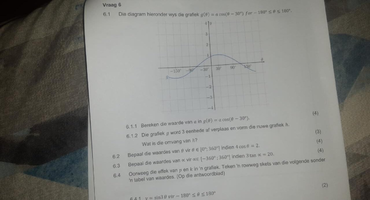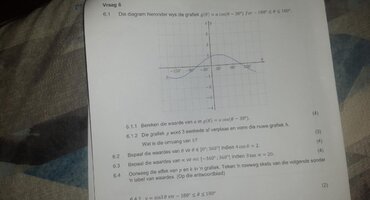You are using an out of date browser. It may not display this or other websites correctly.
You should upgrade or use an alternative browser.
You should upgrade or use an alternative browser.
Calculate amplitude for g(x) = a Cos(x - 30)
- Thread starter urimagic
- Start date
Note,from the given graph, that there is no vertical shift in the graph from the "ideal" graph ofHi friends,
I trust you are all doing well...I have here g(x)=aCos(x-30)...now they ask to calculate "a"...for 4 marks
I know that "a" is the amplitude, and I can read it of the graph, it's 1.
How do we calculate that?..Please help. Thank you kindly.
The paper is in Afrikaans, it's question 6.1.1View attachment 35959
\(\displaystyle g(\theta) = a*cos(\theta)\)
The maximum value of "g" from the graph is ......?
Now think.....

okay, well, the maximum value will be 2, that's peak to peak, so 2 divided by 2 =1..which is peak value (amplitude)..Is this the "calculation" they seek?..I do appreciate your time..sometimes these "little" questions trip me...Note,from the given graph, that there is no vertical shift in the graph from the "ideal" graph of
\(\displaystyle g(\theta) = a*cos(\theta)\)
The maximum value of "g" from the graph is ......?
Now think.....
View attachment 35962
Hi skeeter,amplitude = (trough to peak vertical distance)/2
yes thank you, as I mentioned to khansaheb, The calculation they seek is just peak to peak value, divided by 2?...
You know, the thing is, I know this, but I ...think that sometimes they ask questions that I don't expect they will ask, because..it's so straight forward...anyways, I thank you for your time..
skeeter
Elite Member
- Joined
- Dec 15, 2005
- Messages
- 3,215
I prefer “trough” to “peak” vertical distance for amplitude.Hi skeeter,
yes thank you, as I mentioned to khansaheb, The calculation they seek is just peak to peak value, divided by 2?...
You know, the thing is, I know this, but I ...think that sometimes they ask questions that I don't expect they will ask, because..it's so straight forward...anyways, I thank you for your time.
“Peak” to “peak” horizontal distance would be period of the function.
The Highlander
Full Member
- Joined
- Feb 18, 2022
- Messages
- 937
I would agree with @skeeter that the best way to think of "Amplitude" is as half the (vertical) distance between consecutive peaks & troughs in a Sine/Cosine waveform. You seem to be confusing that with this "peak to peak" thing (perhaps you are thinking of a "+ve peak" and a "-ve peak"?) but "peak to peak" distance (as has also already been pointed out) is a (horizontal) measure of the Period (inTrig graphs) or the Wavelength in general graphs.I have here g(x)=aCos(x-30)...now they ask to calculate "a"...for 4 marks
I know that "a" is the amplitude, and I can read it of the graph, it's 1.
How do we calculate that?..Please help. Thank you kindly.
The paper is in Afrikaans, it's question 6.1.1View attachment 35959
If you have a Trig graph of the form "y = a sin bx + c" or, as in your case, the simpler form: "g(θ) = a cos (θ-30°)" then the value of "a" does, indeed, directly provide the Amplitude of the wave (just as you stated in your post).
However, if my eyesight doesn't deceive me, question 6.1.1 says: "Bereken die waarde van a in g(θ) = a cos (θ-30°)". Now, I have absolutely no knowledge of Afrikaans but Google Translate says this translates into English as: "Calculate the value of a in g(θ) = a cos (θ-30°)" which is what your question specifically asked ("How do we calculate that?").
Unfortunately, it is simply not possible to "calculate" a from the information provided in the question! All you can do is read (or, more accurately, estimate) it from the graph provided!
If, for example, question 6.1.1 had said "Calculate the value of a in g(θ) = a cos (θ-30°) if g(θ) = 0.5 when θ = 90°" then it would have been possible to calculate a value for a but without further 'information' "calculation" is impossible.
Last edited:
Thank you for this great answer. Yes, well, that's the reason I posted this, because as can be seen on my attachment, that is how it was presented..the wave is given, and one can easily see the amplitude value, but yet they ask to calculate it...so..I didn't think myself it could be calculated, therefore my posting that question here. Thanks for the explanation and your time..I really appreciate that...stay blessed..I would agree with @skeeter that the best way to think of "Amplitude" is as half the (vertical) distance between consecutive peaks & troughs in a Sine/Cosine waveform. You seem to be confusing that with this "peak to peak" thing (perhaps you are thinking of a "+ve peak" and a "-ve peak"?) but "peak to peak" distance (as has also already been pointed out) is a (horizontal) measure of the Period (inTrig graphs) or the Wavelength in general graphs.
If you have a Trig graph of the form "y = a sin bx + c" or, as in your case, the simpler form: "g(θ) = a cos (θ-30°)" then the value of "a" does, indeed, directly provide the Amplitude of the wave (just as you stated in your post).
However, if my eyesight doesn't deceive me, question 6.1.1 says: "Bereken die waarde van a in g(θ) = a cos (θ-30°)". Now, I have absolutely no knowledge of Afrikaans but Google Translate says this translates into English as: "Calculate the value of a in g(θ) = a cos (θ-30°)" which is what your question specifically asked ("How do we calculate that?").
Unfortunately, it is simply not possible to "calculate" a from the information provided in the question! All you can do is read (or, more accurately, estimate) it from the graph provided!
If, for example, question 6.1.1 had said "Calculate the value of a in g(θ) = a cos (θ-30°) if g(θ) = 0.5 when θ = 90°" then it would have been possible to calculate a value for a but without further 'information' "calculation" is impossible.
The Highlander
Full Member
- Joined
- Feb 18, 2022
- Messages
- 937
You're very welcome. ?Thank you for this great answer. Yes, well, that's the reason I posted this, because as can be seen on my attachment, that is how it was presented..the wave is given, and one can easily see the amplitude value, but yet they ask to calculate it...so..I didn't think myself it could be calculated, therefore my posting that question here. Thanks for the explanation and your time..I really appreciate that...stay blessed..
(Just add a "Like" ??)

